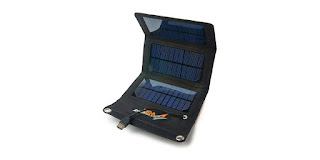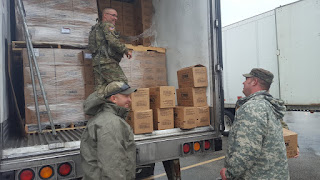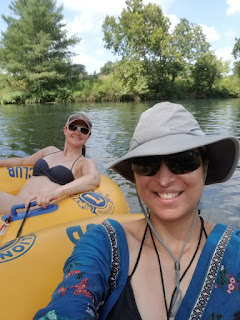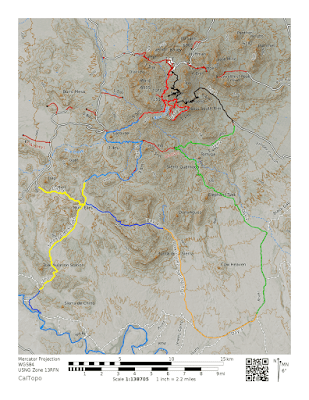Lessons Learned as a Hurricane Harvey First Responder
Lessons Learned During Hurricane Harvey
I recently volunteered to assist in Texas areas affected by Hurricane Harvey. I was with a team that began with high water rescues and searching houses for survivors. We quickly transitioned to handing out life-sustaining supplies at distribution points. Along the way, I learned valuable lessons as a first responder and some of those could be beneficial for impacted area survivors.
 |
| Flipped semi-truck at a distribution point |
Power
With food, water, and shelter provided, I quickly realized power was going to be one of the biggest issues. I had a personal, work, and satellite phone, to receive calls from various people and agencies in support of our mission to help locals. The catch, we were in areas with no power or areas with so many people hooked up to the grid there wasn’t enough power to go around. Thankfully, I took an amazing combination for keeping my communication equipment powered up. I have a StrongVolt 5W solar panel and a KMASHI 1000mAh power bank.
There were some hard lessons learned using my solar panel about having enough space, enough watts, and being weather resistant. First, make sure you have an enough room to lay the panels flat in direct sunlight. I learned that hanging the panels didn't work well and they needed to be flat. Second, most electronics will only charge so fast, no matter how many watts, but a larger panel will provide more power in the shade (like when a cloud blocks the sun). Finally, make sure you get a panel that is weather/water resistant as hurricane weather could lead to more storms. I took a StrongVolt because I bought it on a Woot sale, but there are better or more cost-effective options out there.
 |
| The StrongVolt 5W solar panel. taken from woot.com |
The battery pack I brought turned out to be a keystone piece of equipment. I would charge all of my electronics while sleeping using the battery pack, and throughout the next day, I would use the solar charger to top off the battery pack. Additionally, if there was ever any power, I would use that as well to recharge the battery pack. This method turned out to be an efficient means to keep everything charged and I never had a dead phone as a result. However, I wouldn't have had such a great result with a smaller battery pack.
 |
| KMASHI 10k mAh Battery Pack. Taken from Amazon.com |
Finally, I would definitely add an inverter to my power kit. After returning home, I purchased an Aukey 300W power inverter. The key is to make sure it can charge by 12V auxiliary power outlets and by car batteries with gator clips. This way, any car with a battery provides a means for power, which includes abandoned cars in a bad enough situation.
Food, Water, and Caffeine
Food and water are going to be key for any survivor and first responder, so having a reasonable amount on hand is paramount. MY crew was handing out water and rations three days after Hurricane Harvey made landfall.
 |
| Soldiers handing out rations (MREs) |
I ended up taking a stove for a specific reason and it wasn't water purification, but that is an added bonus. I took the stove to make coffee and that you ended up being a major hit with my crew. As someone who loves caffeine, it seems like this treasure is oft overlooked. If you are interested in learning more about stoves, check out our stove basics 1 and stove basics 2 posts.
 |
| Primus canister stove I used for making coffee |
In the areas we were in there was a water boiling warning. Furthermore, it can be hard to fill up your bathtub beforehand if you know a flood is imminent. This is where a stove, your gas stove in your home or a portable stove, will be key until bottled water or water treatment is restored.
Lastly, everyone needs food to last long enough for supplies to arrive. A lot of people we handed out food too had plenty of food in their refrigerators, but they had no way to keep it cold. I took along some freeze-dried food as insurance in case food was in short supply. It might be worthwhile checking out Wise Foods for some options.
Conclusions
While I know my lessons learned as a first responder aren't going to completely cover the needs for a disaster survivor, there is definitely some carry over. Having a strategy to cover the big three: food, water, and shelter plus power will go a long way.
Let us know any tips and tricks you have when dealing with a natural disaster. Also, if you like the blog follow us on Facebook to keep up to date.
Let us know any tips and tricks you have when dealing with a natural disaster. Also, if you like the blog follow us on Facebook to keep up to date.



All the storms happening make me want to run out and buy a generator of some sort to avoid these issues. Even if I do buy one, it might not even matter if things end up like Puerto Rico with the possibility of no power for months.
ReplyDeleteI have that same instinct to run out and by a generator, but another thing I noticed, people were running out of fuel fast in the first few days. At one point I'd like to try my hand at building a solar generator, which can be made at around half the cost of commercially available units.
DeleteBall park figure for solar generator? Friends went through Harvey with generator. Flooding made it impossible to leave home. Once able to travel there was a gas shortage.
ReplyDeleteThis 3000w one at REI (goo.gl/RGw3cY) cost $3000 with no solar panels, so it can be pretty expensive.
ReplyDelete